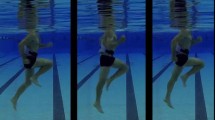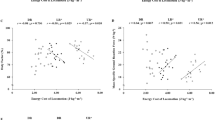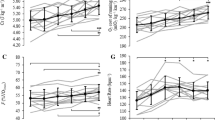Abstract
Purpose
We investigated the influence of a change in stride frequency on physiological and perceptual responses during forward and backward running at different body weight support (BWS) levels.
Methods
Participants ran forward and backward at 0% BWS, 20% BWS, and 50% BWS conditions on a lower body positive pressure treadmill. The stride frequency conditions consisted of forward and backward running at preferred stride frequency (PSF), PSF + 10%, and PSF-10%. We measured oxygen uptake (\(\dot{V}\)O2), carbon dioxide production, heart rate (HR), muscle activity from the lower extremity, and rating of perceived exertion (RPE). Furthermore, we calculated the metabolic cost of transport (CoT).
Results
\(\dot{V}\)O2, HR, CoT, and muscle activity from the rectus femoris were significantly different between stride frequency conditions (P < 0.05). \(\dot{V}\)O2, HR, and CoT during running at PSF + 10% were significantly higher than when running at PSF, regardless of running direction and BWS (P < 0.05). However, RPE was not different between stride frequency conditions (P > 0.05: e.g., 12.8–13.8 rankings in RPE for backward running at 0% BWS).
Conclusions
Manipulation of stride frequency during running may have a greater impact on physiological responses than on perceptual responses at a given speed, regardless of running direction and BWS. Individuals who need to increase their physiological demands during running may benefit from a 10% increase in stride frequency from the PSF, regardless of BWS and running direction.






Similar content being viewed by others
Abbreviations
- BWS:
-
Body weight support
- CoT:
-
Cost of transport
- EMG:
-
Electromyography
- HR:
-
Heart rate
- LBPP:
-
Lower body positive pressure
- partial η2 :
-
Partial eta-squared
- PSF:
-
Preferred stride frequency
- RPE:
-
Rating of perceived exertion
- \(\dot{V}\)O2 :
-
Oxygen uptake
References
Borg GA (1982) Psychophysical bases of perceived exertion. Med Sci Sports Exerc 14:377–381
Beck ON, Taboga P, Grabowski AM (2017) Reduced prosthetic stiffness lowers the metabolic cost of running for athletes with bilateral transtibial amputations. J Appl Physiol 122:976–984. https://doi.org/10.1152/japplphysiol.00587.2016
Cavanagh PR, Williams KR (1982) The effect of stride length variation on oxygen uptake during distance running. Med Sci Sports Exerc 14:30–35
Chan ZYS, Zhang JH, Au IPH, An WW, Shum GLK, Ng GYF, Cheung RTH (2018) Gait retraining for the reduction of injury occurrence in novice distance runners: 1-year follow-up of a randomized controlled trial. Am J Sports Med 46:388–395. https://doi.org/10.1177/0363546517736277
Flynn TW, Connery SM, Smutok MA, Zeballos RJ, Weisman IM (1994) Comparison of cardiopulmonary responses to forward and backward walking and running. Med Sci Sports Exerc 26:89–94
Grabowski AM, Kram R (2008) Effects of velocity and weight support on ground reaction forces and metabolic power during running. J Appl Biomech 24:288–297
Hamill J, Derrick TR, Holt KG (1995) Shock attenuation and stride frequency during running. Hum Mov Sci 14:45–60
Heiderscheit BC, Chumanov ES, Michalski MP, Wille CM, Ryan MB (2011) Effects of step rate manipulation on joint mechanics during running. Med Sci Sports Exerc 43:296–302. https://doi.org/10.1249/MSS.0b013e3181ebedf4
Hermens HJ, Freriks B, Disselhorst-Klug C, Rau G (2000) Development of recommendations for SEMG sensors and sensor placement procedures. J Electromyogr Kinesiol 10:361–374
Hishlop HJ, Montgomery J (2007) Daniel's and worthingham's muscle testing: techniques of manual examination. Saunders/Elsevier, Amsterdam, pp 218, 224, 228–229, 235–236
Hobara H, Sato T, Sakaguchi M, Sato T, Nakazawa K (2012) Step frequency and lower extremity loading during running. Int J Sports Med 33:310–313. https://doi.org/10.1055/s-0031-1291232
Hoogkamer W, Meyns P, Duysens J (2014) Steps forward in understanding backward gait: from basic circuits to rehabilitation. Exerc Sport Sci Rev 42:23–29. https://doi.org/10.1249/JES.0000000000000000
Kline JR, Raab S, Coast JR, Bounds RG, McNeill DK, de Heer HD (2015) Conversion table for running on lower body positive pressure treadmills. J Strength Cond Res 29:854–862. https://doi.org/10.1519/JSC.0000000000000658
Liebenberg J, Scharf J, Forrest D, Dufek JS, Masumoto K, Mercer JA (2011) Determination of muscle activity during running at reduced body weight. J Sports Sci 29:207–214. https://doi.org/10.1080/02640414.2010.534806
Masumoto K, Bailey JP, Mercer JA (2015) Determining if muscle activity is related to preferred stride frequency during running in the water and on land. Eur J Appl Physiol 115:2691–2700. https://doi.org/10.1007/s00421-015-3234-5
Masumoto K, Galor A, Craig-Jones A, Mercer JA (2019) Metabolic costs during backward running with body weight support. Int J Sports Med 40:269–275. https://doi.org/10.1055/a-0806-7537
Masumoto K, Joerger J, Mercer JA (2018) Influence of stride frequency manipulation on muscle activity during running with body weight support. Gait Posture 61:473–478. https://doi.org/10.1016/j.gaitpost.2018.02.010
Masumoto K, Soucy MT, Bailey JP, Mercer JA (2017) Muscle activity during backward and forward running with body weight support. Hum Mov Sci 55:276–286. https://doi.org/10.1016/j.humov.2017.08.015
McNeill DK, de Heer HD, Williams CP, Coast JR (2015) Metabolic accommodation to running on a body weight-supported treadmill. Eur J Appl Physiol 115:905–910. https://doi.org/10.1007/s00421-014-3071-y
Mercer JA, Applequist BC, Masumoto K (2013) Muscle activity while running at 20%–50% of normal body weight. Res Sports Med 21:217–228. https://doi.org/10.1080/15438627.2013.792084
Mercer JA, Dolgan J, Griffin J, Bestwick A (2008) The physiological importance of preferred stride frequency during running at different speeds. J Exerc Physiol 11:26–32
Messier SP, Martin DF, Mihalko SL, Ip E, DeVita P, Cannon DW, Love M, Beringer D, Saldana S, Fellin RE, Seay JF (2018) A 2-year prospective cohort study of overuse running injuries: the runners and injury longitudinal study (TRAILS). Am J Sports Med 46:2211–2221. https://doi.org/10.1177/0363546518773755
Milner CE, Ferber R, Pollard CD, Hamill J, Davis IS (2006) Biomechanical factors associated with tibial stress fracture in female runners. Med Sci Sports Exerc 38:323–328. https://doi.org/10.1249/01.mss.0000183477.75808.92
Ordway JD, Laubach LL, Vanderburgh PM, Jackson KJ (2016) The effects of backwards running training on forward running economy in trained males. J Strength Cond Res 30:763–767. https://doi.org/10.1519/JSC.0000000000001153
Raffalt PC, Hovgaard-Hansen L, Jensen BR (2013) Running on a lower-body positive pressure treadmill: VO2max, respiratory response, and vertical ground reaction force. Res Q Exerc Sport 84:213–222. https://doi.org/10.1080/02701367.2013.784721
Snyder KL, Farley CT (2011) Energetically optimal stride frequency in running: the effects of incline and decline. J Exp Biol 214:2089–2095. https://doi.org/10.1242/jeb.053157
Terblanche E, Page C, Kroff J, Venter RE (2005) The effect of backward locomotion training on the body composition and cardiorespiratory fitness of young women. Int J Sports Med 26:214–219. https://doi.org/10.1055/s-2004-820997
Threlkeld AJ, Horn TS, Wojtowicz G, Rooney JG, Shapiro R (1989) Kinematics, ground reaction force, and muscle balance produced by backward running. J Orthop Sports Phys Ther 11:56–63
Williford HN, Olson MS, Gauger S, Duey WJ, Blessing DL (1998) Cardiovascular and metabolic costs of forward, backward, and lateral motion. Med Sci Sports Exerc 30:1419–1423
Funding
This study was supported by a Grant-in-Aid for Scientific Research (C) from the Japan Society for the Promotion of Science (JSPS KAKENHI Grant Number JP16K01663).
Author information
Authors and Affiliations
Contributions
KM and JAM conceived and designed the research. KM, DD, ACJ, and JAM conducted the experiments. KM and JAM analyzed the data. KM and JAM wrote the manuscript. All authors read and approved the final version of manuscript.
Corresponding author
Ethics declarations
Conflict of interest
The authors declare that they have no conflict of interest.
Ethical approval
All procedures performed in studies involving human participants were in accordance with the ethical standards of the institutional research committee (University Institutional Review Board of the University of Nevada, Las Vegas, United States, code:1104369-4) and with the 1964 Helsinki declaration and its later amendments or comparable ethical standards.
Informed consent
Written informed consent was obtained from all individual participants included in the study.
Additional information
Communicated by Jean-René Lacour.
Publisher's Note
Springer Nature remains neutral with regard to jurisdictional claims in published maps and institutional affiliations.
Rights and permissions
About this article
Cite this article
Masumoto, K., Denton, D., Craig-Jones, A. et al. The effects of stride frequency manipulation on physiological and perceptual responses during backward and forward running with body weight support. Eur J Appl Physiol 120, 1519–1530 (2020). https://doi.org/10.1007/s00421-020-04380-y
Received:
Accepted:
Published:
Issue Date:
DOI: https://doi.org/10.1007/s00421-020-04380-y




